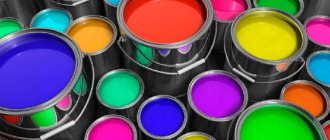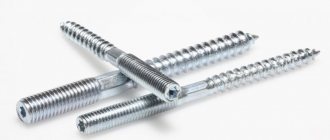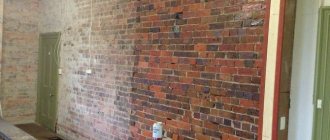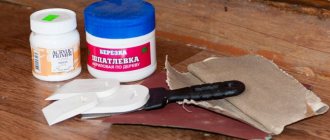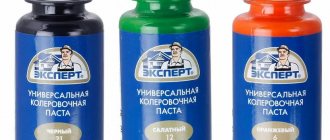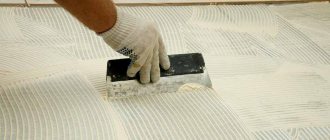What is a solvent and why is it needed?
A solvent is a rapidly evaporating inorganic or organic substance. Depending on the composition it may be:
- one-component;
- multicomponent.
Depending on the type of substance included in the composition, one-component solvents are divided into:
- organic (turpentine, kerosene, white spirit, solvent, gasoline);
- inorganic (water, liquid ammonia, phosphorus and sulfur salts).
Organic solvents, despite the smell, are more in demand, and according to the rate of evaporation they are divided into the following types:
- difficult to volatilize are used for diluting car enamels and oil paints. This group includes the well-known turpentine;
- medium-volatile ones are suitable for acrylic or oil-based compositions. This type includes kerosene, which undergoes special purification and only after that acquires the necessary properties;
- highly volatile ones are used for car enamels, acrylic paints and varnishes and oil-based compositions. This includes white spirit, gasoline and solvent.
On a hot day, when direct sunlight inevitably hits the already high temperature, it is better to use the third type, in the cool season - the first.
In addition to diluting paint compositions and restoring them when they dry, before direct application to the surface, it must be degreased. This will help increase the level of adhesion, especially if the surface is very smooth, such as metal. In addition, the paint will be easier to spread over the surface, and the dried layer will be smooth and uniform. If the paint coating is applied not with a regular brush or roller, but with special sprayers, there may be a need to reduce the density and viscosity of the composition. An accidental drop that was not noticed in time and had time to dry can be easily wiped off with a suitable product. For a successful result, you only need to correctly select a solvent that matches the type of paint used .
Polyurethane paints and varnishes (paints, varnishes, primers) are a large group of polymers:
- The main component of polyurethane resins are polyols, synthesized on the basis of substances traditionally used for alkyd paints and varnishes, therefore the price of polyurethane materials is relatively low. Polyols are oligomers consisting of fairly large molecules with about several dozen active sites.
- The second component of polyurethanes are diisocyanate-based hardeners, consisting of small molecules with two active sites. During film formation, the active sites of diisocyanates bind to the active sites of polyols, and a urethane bond is formed.
- One polyol molecule can be linked by diisocyanates to many other polyol molecules, and so on. In this way, films of polyurethane coatings are obtained that have a branched three-dimensional mesh structure. Such films are resistant to water, acids, mineral and organic oils, gasoline, and oxidizing agents.
The vapor permeability of polyurethane paints, varnishes, and primers is an order of magnitude lower than that of nitrocellulose paints.
Polyurethane paints
, varnishes, and primers are used mainly for finishing wooden products indoors.
The ratio of components in polyurethane paints and varnishes
The components of the working mixture of polyurethane paints and varnishes are usually mixed with two parts of resins plus one part of hardener immediately before use, since the lifetime of polyurethane materials is short: 3-6 hours.
The ratio of base and hardener in the working mixture is such that the number of bonds between molecules is equal to 60-90% of the maximum possible.
Deviations of the amount of hardener in the working mixture from the specified proportion within ±10% do not lead to a significant change in the properties of the coating.
Operating principle
To understand this process, you need to know which component is the main one in a particular coloring composition. Consequently, the solvent is selected with a similar composition. When you add it to dried paint, it will complement its composition and replenish the evaporated part of the base. Thus, you will be able to achieve almost its original condition. The main thing is to thoroughly mix the components together, reaching to the very bottom, so that the solvent does not float on the surface and the composition becomes uniform in thickness.
Basically, all interior paints are sold ready-to-use and do not require additional dilution.
Only in the cases described above. There are a few simple rules that you can follow to achieve the best results:
- The dishes in which you will do the work must be clean. No dried paint fragments from previous uses and no small debris. Rinse it with water and wipe dry.
- The most suitable containers are those that have a cylindrical shape with smooth walls. In such a vessel you can move the components as evenly as possible.
- If we are talking about paints that must be diluted with water, then its part should be no more than 10% of the total mass.
- In alkyd enamels that will be used for exterior work, it is necessary to add no more than 3% of the total amount of liquid.
- For interior work – no more 5%.
If you add too much solvent, your paint will not adhere and will simply run off the surface being treated. This is especially true for vertical planes, on which drips instantly form. At the same time, the performance indicator and service life of the coating are reduced Let's take a closer look at the most common types of interior paints and the types of solvents suitable for them.
Yacht varnishes
Yacht (or yacht) varnish is one of the most effective means of protecting natural wood surfaces. Already from the name the features of the area where it is used are clear. At the same time, the yacht composition is excellent for woodworking inside and outside of any objects (not just boats, boats, yachts). It is impervious to moisture, temperatures, and aggressive environments.
Yacht varnish. Basic properties:
- high degree of protection of wooden structures;
- physical and mechanical immunity to the influence of external environments;
- durability, extending the life of wood.
To achieve such results, toxic chemical elements (toluene, xylene) are used in the production of the material. There are several production technologies:
- alkyd yacht (based on the organic solvent white spirit);
- urethane-alkyd yacht (the eluent is the same, but in smaller quantities);
- alkyd-urethane yacht (solvent additives are highly volatile);
- acrylates (water-based compounds).
Dilutes yacht varnish with white spirit, no more than 5% of the total volume. The solvent acts on the substance only in its fresh form. After drying, the varnished parquet coating will become impervious.
Varnish for yachts, boats, boats has high wear resistance and can also be diluted with white spirit
Solvent for alkyd paints
These are oil compositions based on drying oil and enamel compositions based on varnish. Resins are added as foaming agents. Depending on their type, pentaphthalic (marking - PF) or glyphthalic (GF) enamels are distinguished. In addition to liquid paints based on drying oil, thickly grated compositions are also produced (GF-013, PF-014, etc.). They are used for both external and internal work when finishing plastered, wooden or metal surfaces. They are fire hazardous, but at the same time absolutely non-toxic and light-resistant.
- The most common and affordable means for diluting this type of paint is White Spirit. It is obtained during the distillation of petroleum products. Despite this, it is considered one of the most harmless and has the least pungent odor. It is also used for elimination oil spots from the surface before applying the coating and eliminating the viscous defect. With its help, you can rinse your brushes after work, speed up the drying process of oil compositions, and protect the wooden surface from moisture and bark beetles.
- Turpentine is obtained by distilling resin from softwood. Most often used as a thinner and degreaser . You will not confuse this solvent with any other because of its pungent and unpleasant odor. Paint thinned with turpentine will take much longer to dry, which is sometimes necessary. When it comes into contact with the skin in small quantities, it does not cause burns or irritation if it has a high degree of evaporation. However, the surface treated with this composition will be flammable.
- Solvent obtained from the pyrolysis of petroleum raw materials or from the coking of coal. It is a composition of light hydrocarbons. Possesses very pungent odor and is toxic and flammable. Therefore, when working with it, it is necessary to ensure air access to the room. And keep containers with it in a ventilated place without direct sunlight. When added to paint, it is able to dry in a very short period of time, thanks to its high degree of evaporation. It does an excellent job of removing oil and wax stains.
- Xylene (P-646) is an organic chemical compound obtained during the distillation of petroleum. It is a liquid with a slight odor and a very high evaporation rate. Used as a thinner to obtain compositions of the required viscosity or to remove alkyd paints from the surface. In the first case, it is added in small portions and mixed thoroughly. In case of contact with skin or mucous membranes, it causes irritation. Therefore, work with it must be carried out in protective clothing and gloves, and in case of contact, quickly rinse with soap and water under running warm water.
Alkyd paints in the home are most often used for painting ceilings, walls in wet rooms, doors, window frames, heating radiators or various pieces of furniture due to the fact that they form a denser and more durable coating. When choosing a solvent, carefully read the directions on the labels, because not all of them are suitable for working on wooden surfaces.
A few rules for handling solvents:
- They are mainly explosive, so you need to work with them away from smoking areas, fire, switches and switches.
- Many solvents are toxic, so the room where you work with them should be well ventilated.
- It is necessary to avoid contact of the solvent with mucous membranes, wounds and the skin in general. In case of contact, rinse the area thoroughly with water.
- Most solvents mercilessly damage fabrics, so it is important to prevent contact with clothing.
Solvent for silicate compounds
Silicate paints belong to the category of mineral paints, since the basis for them is liquid glass. They are fireproof, breathable and weakly resistant to moisture. Can be used for finishing plastered, stone or concrete surfaces indoors and outdoors. To dissolve this type of coating, you do not need to resort to the use of aggressive substances with pungent odors. It is enough to use a silicate primer, which can be found in any hardware store.
Solvent for emulsion and adhesive paints
Emulsion paints are divided into water-based, latex, acrylic, polyvinyl acetate and water-dispersion. They can be applied to concrete, metal, wood or plaster surfaces. They are non-toxic and fireproof. Adhesive compositions are made based on aqueous solutions of organic polymers, for example, cellulose ether, polyvinyl alcohol, starch and casein. Their properties are very similar to emulsion ones, but are less resistant to moisture. Because of this, they are used for painting inside dry rooms. These types of paints and varnishes are practically odorless, and due to their simple composition they can be dissolved with ordinary water in small quantities.
Dried acrylic paint can be removed from tools by simply soaking it in a soapy solution. For acrylic-based paints, solvents such as IT spirit, kerosene, solvent and gasoline are suitable.
What belongs to the organic group
Due to their properties, compounds from this group have become truly widespread. They are used in the production of painting products. The materials can be used even under aggressive environmental conditions. It’s just that few people are able to immediately understand which substance belongs to which group. But here everything seems complicated only at first glance. The following information will help you understand paint thinners:
- The group with hydrocarbons and their derivatives includes xylene, solvent, turpentine, and refined gasoline. Including such products as Galosha and Nefras gasoline.
- These compounds include a variety of ketones: cyclohexanone, disobutyl ketone, methyl ethyl ketone, acetone.
- Examples of ethers and ethers are: methyl acetate, ethyl acetate, dioxane.
- Finally, the group of alcohols has the following varieties: isopropanol, butanol, ethanol. Each group has its own solvent consumption.
On the video: thinners and solvents - how they differ.
Characteristics of some solvents according to their number
Due to the emergence of a large number of different types of multicomponent solvents, the most common and frequently used of them were assigned numbers. This makes the choice much easier.
- R-4 is an acetone based that is very volatile. Basically, it is used to dissolve alkyd paints , varnishes and enamels based on chlorinated polymers. Its use a positive effect on the consistency of the dye and its film-forming ability. In extreme cases, it can be used to degrease the surface, but you will have to work very quickly due to its high degree of evaporation. When working with this substance, it is necessary to follow fire safety rules and use personal protective equipment, as it is flammable.
- Solvent 646 – universal a composition that is used both in everyday life and in industry. Its versatility is explained by its multicomponent, complex composition. They can also paint dissolve, and surface degrease, and wipe off the old coating. It has a yellowish color and is very pungent odor which disappears immediately after drying. When applied to a surface it is very evaporates quickly and paint diluted with it dries too quickly. Sometimes this causes inconvenience, and it is replaced with weaker solutions. But the dried surface becomes smooth and shiny. They can breed Not only paint, but also some types of putty. His affordable price and availability in any store made solvent 646 the most famous and in demand.
- RS-2 is a transparent , pale yellow based on xylene and white spirit, which also has good properties. It is used to dissolve oil varnishes, bitumen paints and pentaphthalic enamels. It evaporates very quickly, but is very dangerous. Its extremely toxic vapors have a strong effect on the central nervous system, internal organs, respiratory organs, skin, blood and even bone marrow. And with prolonged contact with unprotected skin, it provokes a rash. Also, when its vapor accumulates in the air, an explosion can occur. Therefore, when working with the RS-2, you must be very careful, use goggles, gloves, a respirator, and ventilate the room well.
- RFG is a mixture of ethyl or isopropyl alcohol with butyl or isobutyl alcohol in a 3:1 ratio. It is used for diluting primer paints;
- R-647 is suitable for thinning nitrocellulose enamels and primers;
- R-649 and R-650 - for diluting glyphthalic and nitrocellulose enamels and primers;
- RKCh is a solvent for rubber-based paints. So toxic that you need to wear a protective suit to work with it;
- PC (1-2) is suitable for oil paint;
- RE (1-4) - compositions for working with enamels.
Be careful, all solvents whose number begins with the letter “P” are industrial, and therefore extremely hazardous to health.
Homogeneous
Consist of one substance or a mixture of homogeneous components. Advantages: versatility, prevalence and affordable cost.
Water
It does not dissolve, but dilutes paintwork materials, so it is more correct to call it a thinner. Suitable for acrylic brands, water-based emulsions, and some adhesives. The disadvantage is a reduction in the overall service life: a thin film forms on the surface of the coloring matter quite quickly. She says that the mixture is unsuitable for use.
Gasoline, nefras, gasoline galoshes
Petroleum derivatives. Flammable, evaporates easily. Explosive at high concentrations in air.
Suitable for diluting oil and bitumen (for example, primer NK-50), paint and varnish materials. They have a pronounced specific aroma.
Turpentine
A volatile liquid of transparent white or yellowish color, insoluble in water. It is obtained by processing pine resin, which explains the pronounced pine aroma. Ignites at a temperature of 160 degrees.
Dilutes:
- varnishes;
- enamels;
- oil and alkyd-styrene grades.
Used in pure form or in combination with other organic diluents.
White Spirit
The high-boiling fraction of gasoline looks like an oily, colorless liquid with a kerosene aroma. It is highly flammable and therefore requires careful handling. It is prohibited to store and use near open sources of fire.
Dissolves:
- oil, alkyd, resin paints and enamels (including PF-115, PF-133, PF-266);
- bitumen-kukersol mastic;
- varnish GF-166;
- Kuzbasslak;
- soil GF-021.
It’s cheap, so it’s popular with both professional builders and amateurs. They are convenient for cleaning tools and degreasing the product or structure being painted.
Petroleum solvent
It is a clear or slightly yellow liquid substance obtained by distilling petroleum. Belongs to the first class of flammable compounds. A mandatory requirement for storage and use is the presence of a supply and exhaust ventilation system.
Increases fluidity:
- bitumen or glyphthalic dyes;
- alkyd paintwork, including melamine alkyd;
- heat-resistant enamels for metal;
- oil paints;
- bitumen and rubber mastics.
Capable of breaking down vegetable fats and oils, petroleum fractions, organocompounds of sulfur, oxygen, and nitrogen. Widely applicable in everyday life. Low toxicity: if necessary, you can use it to wipe off stains from exposed skin.
Petroleum xylene
Petroleum product. It is used in the chemical industry at one of the technological stages of dye synthesis. Suitable for diluting glyphthalic and bitumen varnishes, epoxy. After adding it, the paintwork takes longer to dry, but shines brighter.
Belongs to the third class of danger. Explosion and fire hazard.
Acetone
An organic substance from the group of saturated ketones. In demand in the production of polycarbonates, polyurethanes, epoxy resins. It is used to reduce the viscosity of perchlorovinyl compounds, dissolve oils, salts, and remove wax and rubber residues.
Safety precautions
Never neglect your own safety! Especially when working with toxic vapor-forming substances such as solvents and paints. Be sure to follow the basic rules:
- personal equipment is mandatory : goggles, a respirator, gloves, and in particularly dangerous cases, a protective chemical suit.
- If the substance comes into contact with an open area of skin, immediately rinse the area with plenty of water.
- Always work in a ventilated area, otherwise you may be exposed to toxic fumes. And when using particularly aggressive substances - an explosion.
- Maintain normal room temperature Elevated temperatures, operating heating elements or open flames are prohibited conditions.
- After finishing All containers must be screwed tightly and placed in a ventilated place away from direct sunlight. Storage is allowed only in a vertical position - with the plugs facing up.
The article was written for the site.
Tags: Enamels and paints
Rules for working with solvents
Almost all organic solvents have varying degrees of impact on human health, depending on the type. In order not to suffer from toxic fumes when working with them, you must strictly follow safety precautions:
- use personal protective equipment during work, such as gloves, a respirator, safety glasses, etc.;
- if the substance gets on the skin, it should be washed off immediately before it has time to act or has minimal effect;
- ensure access to a sufficient amount of fresh air;
- It is necessary to control the temperature in the room, because some solvents become explosive when in contact with warm air;
- The flammability and flammability of these substances should also be taken into account; work near an open flame is unacceptable; smoking or simply the presence of hot objects nearby is also dangerous;
- Solvents should be stored in a cool room, in small bottles or canisters, which must have labels;
- All containers must be positioned with their corks facing up; they must not be placed on their sides or with their corks facing down.
